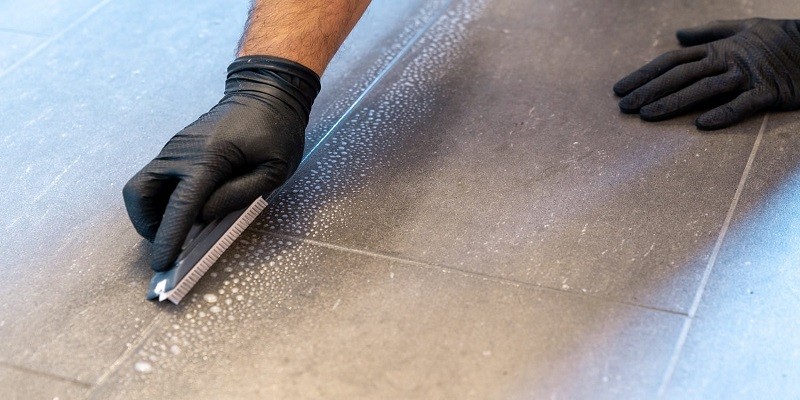Last Updated on September 11, 2023
To professionally clean your grout, start by mixing equal parts of water and vinegar in a spray bottle. Spray the solution onto the grout lines, then scrub with a stiff brush.
Rinse the area with clean water and wipe dry with a cloth. Grout, the material used to fill the gaps between tiles, can easily accumulate dirt, stains, and mold. Regular cleaning is essential to maintain the appearance and longevity of your tiled surfaces.
In this guide, we will walk you through the steps to clean grout professionally, using a simple and effective homemade solution. By following these instructions, you can restore the original color and cleanliness of your grout without the need for harsh chemicals or expensive cleaning products. Get ready to transform your grout from dingy to dazzling!
Signs That Your Grout Needs Professional Cleaning
Is your grout looking dull and dirty? It might be time for professional cleaning. Restore the beauty of your tiled surfaces with expert grout cleaning services.
Grout, the material used to fill the gaps between tiles, is prone to dirt, stains, and wear over time. Regular cleaning and maintenance are essential to keep your grout looking its best. However, there are certain signs that indicate it’s time to bring in the professionals for a deep cleaning.
Here are three common signs that your grout is in need of professional attention:
Discoloration and stains:
- Dark or discolored grout lines can be a clear sign that dirt and grime have built up over time.
- Stains from spills, liquids, or other substances may have penetrated the grout and become embedded, making it difficult to remove with regular cleaning methods.
- If your efforts to clean the grout result in minimal improvement or the stains return quickly, it’s a good indicator that a professional cleaning is necessary.
Mildew and mold growth:
- Grout in damp or humid environments, such as bathrooms or kitchens, is susceptible to mildew and mold growth.
- The presence of black spots or a musty smell indicates mold or mildew has started to colonize in the grout.
- Mold and mildew not only make the grout look unsightly but can also pose health risks if left untreated. Professional cleaning can effectively remove mold and mildew, restoring the cleanliness of your grout.
Unpleasant odors:
- Lingering odors that emanate from your grout, even after cleaning, could indicate trapped dirt, moisture, or mildew.
- The accumulation of bacteria, germs, and other organic matter in the grout can emit unpleasant smells.
- Professional cleaning methods can eliminate the source of the odor and leave your grout smelling fresh and clean.
By recognizing these signs, you can address the need for professional grout cleaning promptly. Restoration and rejuvenation by experts will not only enhance the appearance of your grout but also extend its lifespan.
Identifying The Type Of Grout And Surface
When professionally cleaning your grout, it’s crucial to identify the type of grout and surface for an effective result. By understanding the specific characteristics, you can employ the appropriate cleaning methods and products, ensuring a thorough and successful cleaning process.
Grout is an essential component of tile installation, and professionally cleaning it requires understanding the type of grout and surface you are dealing with. By correctly identifying the grout and surface, you can determine the appropriate cleaning method and products to use.
Below, we will delve into the characteristics of different types of grout and surfaces commonly found in households:
Cementitious Grout:
- Cementitious grout is the most common type of grout used in tile installations.
- It is a mixture of cement, sand, and water, which sets and hardens over time.
- Cementitious grout is available in sanded and unsanded varieties, with sanded grout being suitable for wider grout lines.
- The surface of cementitious grout is porous, making it prone to staining and dirt buildup.
Epoxy Grout:
- Epoxy grout is a durable and stain-resistant type of grout that is gaining popularity due to its many benefits.
- It is composed of epoxy resins and a filler powder, which results in a non-porous and waterproof finish.
- Epoxy grout is more expensive than cementitious grout but offers superior resistance to stains, chemicals, and moisture.
- It is a suitable choice for high-moisture areas such as bathrooms and kitchens and is often used with tiles made of natural stone or porcelain.
Porcelain Tiles:
- Porcelain tiles are known for their durability, versatility, and low maintenance requirements.
- They are made from dense ceramic materials, which make them highly resistant to stains, water, and wear.
- Porcelain tiles come in various finishes, such as glazed and unglazed, and they can mimic the appearance of natural stone or wood.
- The surface of porcelain tiles is usually smooth and non-porous, making them easier to clean and maintain.
Natural Stone Tiles:
- Natural stone tiles, such as marble, granite, slate, and travertine, add elegance and beauty to any space.
- Each type of natural stone tile has its unique properties and characteristics.
- Natural stone tiles require special care due to their porous nature, which makes them susceptible to staining.
- It is essential to identify the specific type of natural stone and use appropriate cleaning methods and products to avoid damaging the surface.
Identifying the type of grout and surface is the first step towards professionally cleaning your grout. Once you have determined the grout and surface materials, you can proceed with selecting the most suitable cleaning methods and products to ensure a thorough and effective cleaning process.
Keep in mind that different types of grout and surfaces may require specific cleaning techniques to achieve the best results.
Gathering The Necessary Tools And Materials
To professionally clean your grout, start by gathering the essential tools and materials needed for the task. This involves collecting items such as a grout brush, cleaning solution, and protective gloves to ensure a thorough and effective cleaning process.
If you’re struggling with dirty grout and want to give it a professional cleaning, gathering the necessary tools and materials is the first step to achieving a sparkling clean finish. This section will guide you through the essential items you’ll need for the job.
Let’s dive right in!
Grout Cleaner Solution:
- Look for a commercial grout cleaner solution that suits your specific needs.
- Opt for a formula that is safe for your tile and grout type.
- Consider eco-friendly or homemade options for a more sustainable approach.
Scrub Brush Or Grout Brush:
- A scrub brush with stiff bristles is ideal for tackling deep-seated grime in your grout lines.
- Alternatively, a grout brush specifically designed for this task can provide targeted cleaning.
- Choose a brush with a comfortable handle to ensure ease of use during the cleaning process.
Microfiber Cloths:
- Microfiber cloths are essential for wiping away excess grout cleaner solution and drying the surface.
- These cloths are highly absorbent and effective at trapping dirt without leaving lint behind.
- Ensure you have enough microfiber cloths to complete the cleaning job thoroughly.
Protective Gloves And Goggles:
- When working with cleaning solutions, it’s important to protect yourself.
- Wear protective gloves to shield your hands from direct contact with harsh chemicals.
- Goggles will safeguard your eyes from any potential splashes or fumes.
Gathering these tools and materials will set you up for success in professionally cleaning your grout. Remember to follow the instructions on your grout cleaner solution and take necessary safety precautions. With the right equipment in hand, you’re ready to tackle the grime and restore the beauty of your grout lines.
Let’s get started!
Pre-Cleaning Preparations
Prepare your grout for professional cleaning with thorough pre-cleaning preparations. Follow these steps to ensure effective and efficient grout cleaning.
Clearing The Area:
- Before you start cleaning your grout, it’s important to clear the area of any obstacles or furniture. This will provide you with a clear space to work and ensure that you don’t accidentally damage any items.
- Remove any rugs, mats, or objects that are on or near the grout lines.
- Clear the area of any loose items or debris, such as dirt, dust, or crumbs, as they can interfere with the cleaning process.
Removing Loose Dirt And Debris:
- Begin by sweeping or vacuuming the grout lines to remove any loose dirt or debris. This will help to prevent scratching or spreading dirt around during the cleaning process.
- Use a soft-bristled broom or a vacuum cleaner with a brush attachment to gently sweep or vacuum the grout lines.
- Pay attention to corners and hard-to-reach areas where dirt and debris tend to accumulate. A small brush or toothbrush can be useful for cleaning these areas.
Protecting Adjacent Surfaces:
- It’s essential to protect adjacent surfaces, such as tiles or countertops, to ensure they don’t get damaged during the cleaning process.
- Use painter’s tape or masking tape to cover the edges of adjacent surfaces that come into contact with the grout lines. This will provide a barrier and prevent any cleaning solution or scrubbing from affecting the surrounding surfaces.
- Make sure the tape is securely attached and covers the entire edge of the adjacent surfaces, leaving no exposed areas.
By following these pre-cleaning preparations, you can ensure a smooth and effective grout cleaning process. Removing obstacles and loose dirt, as well as protecting adjacent surfaces, will set the stage for a successful cleaning experience.
Applying The Grout Cleaner
Apply the grout cleaner to professionally clean your grout and restore its original shine. Ensure thorough coverage and gently scrub the cleaner into the grout lines using a brush. Rinse the area and wipe away any residue for a pristine finish.
Cleaning your grout professionally starts with applying the right cleaner effectively. Follow these steps to ensure a thorough and successful cleaning process:
- Spray or apply the cleaner onto the grout: Begin by spraying or applying the grout cleaner directly onto the grout lines. Be sure to cover the entire area that needs cleaning. This will help to loosen dirt, stains, and buildup, making it easier to remove.
- Allowing the cleaner to penetrate: After applying the cleaner, give it some time to penetrate the grout. The cleaner needs time to work its magic and break down any stubborn stains or grime. Depending on the cleaner’s instructions, this could range from a few minutes to several minutes.
- Diluting the cleaner as needed: In some cases, the grout cleaner may need to be diluted. Follow the manufacturer’s instructions if dilution is necessary. When diluting, ensure you use the correct ratio of cleaner to water. This step is crucial to achieve the desired cleaning potency without causing any damage to the grout.
By following these steps and allowing the cleaner to work its magic, you’ll be well on your way to professionally clean grout lines. Remember to always read and follow the instructions provided by the manufacturer for the best results.
Now that you know how to apply the grout cleaner, let’s move on to the next step: scrubbing the grout to remove dirt and stains.
Agitating The Grout
To professionally clean grout, agitate the grout using a brush or a grout cleaner tool. This helps to loosen dirt and stains for a thorough cleaning.
:
Maintaining clean and fresh grout can enhance the appearance of your floors or walls and prolong the lifespan of your tiles. One key step in professionally cleaning grout is agitating it. This process helps in loosening dirt, grime, and stains to make them easier to remove.
Let’s explore how you can effectively agitate the grout to achieve impressive cleaning results.
Scrubbing The Grout Lines With A Grout Brush:
• Use a grout brush with stiff bristles to effectively scrub the grout lines.
• Start by dampening the grout lines using warm water. This will help to loosen any surface dirt and grime.
• Apply a grout cleaner or a homemade solution of baking soda and water onto the grout lines.
• Holding the grout brush at a 45-degree angle, scrub the grout lines in a back-and-forth motion.
• Ensure that you scrub along the full length of each grout line to eliminate dirt and stains thoroughly.
Employing Circular Motions For Stubborn Stains:
• For stubborn stains that require extra attention, employ circular motions while scrubbing the grout lines.
• Apply more pressure to the brush and scrub the affected area in small circular motions.
• Keep repeating the circular motions until the stain starts to fade or disappear.
• Circular motions help to agitate the grout more effectively, allowing the cleaning agent to penetrate deep into the grout lines.
Avoiding Scrubbing Too Aggressively On Delicate Surfaces:
• It’s important to be cautious and avoid scrubbing too aggressively on delicate surfaces to prevent damage.
• Delicate surfaces such as natural stone or glazed tiles require gentler scrubbing with a softer bristle brush.
• Adjust the pressure and angle accordingly to ensure you do not cause any scratches or damage to the surface.
• Take your time and be patient when agitating the grout on delicate surfaces, as a gentle approach yields better results without compromising the integrity of the tiles.
By effectively agitating the grout using these techniques, you can ensure a thorough cleaning process. Remember to choose the appropriate tools and methods based on the grout and surface you are working with. In the next section, we will explore further steps to achieve professional grout cleaning results.
Rinsing And Drying The Grout
To professionally clean your grout, one important step is to thoroughly rinse and dry it. This ensures that any cleaning solution or dirt residue is completely removed, leaving your grout clean and fresh.
Cleaning your grout is only half the battle. Once you’ve applied the grout cleaner solution and scrubbed away the dirt and grime, it’s crucial to properly rinse and dry the grout to achieve a professionally clean finish. Follow these steps for effective rinsing and drying:
Wiping Away The Grout Cleaner Solution With A Damp Cloth
- Using a damp cloth, thoroughly wipe away the grout cleaner solution from the surface of the grout.
- Ensure that all traces of the cleaning solution are removed to prevent any residue or haze from forming on the grout.
- Take care to reach all corners and edges, making sure no areas are left untouched.
Repeating The Process If Necessary
- Inspect the grout after rinsing to determine whether any stubborn stains or dirt spots remain.
- If required, repeat the cleaning process using the grout cleaner solution and scrubbing technique until the grout is completely clean.
- Some heavily soiled grout may require multiple cleaning sessions for optimal results.
Ensuring Complete Drying Before Sealing
- Before proceeding to seal the grout, ensure that it is completely dry. Moisture can trap within the grout, leading to mold and mildew growth over time.
- Allow ample time for the grout to air dry naturally. This usually takes at least 24 to 48 hours.
- Avoid applying any sealant until the grout is thoroughly dried.
Remember, the meticulous rinsing and drying process is essential to achieve a professional-looking grout finish. By following these steps, you can ensure that your grout remains clean, free from residue, and ready for the next step of sealing. Take your time and don’t rush through this crucial stage for the best results.
The Importance Of Sealing
Understanding the importance of sealing is crucial for professionally cleaning your grout. With the right techniques and products, you can ensure a thorough and long-lasting cleaning process.
Grout, an essential component of tiled surfaces, often becomes a breeding ground for stains, discoloration, and bacteria. To ensure your grout stays clean and retains its original appearance, it is crucial to understand the importance of sealing. Sealing your grout not only enhances its aesthetic appeal but also provides several other benefits, including preventing future stains and discoloration, extending its lifespan, and simplifying future cleaning efforts.
Preventing Future Stains And Discoloration
- Sealing your grout creates a protective barrier that prevents liquids and substances from penetrating the surface.
- The sealant acts as a shield, making it easier to clean spills and preventing them from seeping deep into the grout.
- By sealing your grout, you can avoid pesky stains, such as those caused by spills, dirt, grease, or even mildew growth.
Extending The Lifespan Of Your Grout
- Regular sealing helps slow down the natural wear and tear grout experiences over time.
- The sealant preserves the structural integrity of the grout, preventing it from deteriorating prematurely.
- By extending the lifespan of your grout, you can avoid the hassle and expense of replacing it frequently.
Simplifying Future Cleaning Efforts
- Sealed grout is much easier to maintain and keep clean than unsealed grout.
- The sealant forms a protective layer that repels dirt, grime, and other contaminants, making them easier to remove.
- With sealed grout, you’ll spend less time and effort scrubbing and more time enjoying your beautifully maintained tiled surfaces.
By understanding the importance of sealing your grout and taking the necessary steps to protect it, you can enjoy long-lasting, clean, and beautiful tiled surfaces. Prevent future stains and discoloration, extend the lifespan of your grout, and simplify your future cleaning efforts by making sealing an integral part of your grout maintenance routine.
Choosing The Appropriate Grout Sealer
Choosing the right grout sealer is essential for professionally cleaning your grout. It helps to protect and maintain the appearance of your tiles, ensuring a clean and long-lasting result. So, make sure to choose the appropriate grout sealer to keep your grout looking fresh and beautiful.
When it comes to professionally cleaning your grout, selecting the right grout sealer is crucial. It not only protects your grout from stains and moisture but also enhances its overall appearance. There are different types of grout sealers available, each serving a specific purpose.
Let’s explore three common types of grout sealers and their benefits:
Penetrating Sealer:
- Suitable for most types of grout, including porous and dense varieties.
- Penetrates the grout, creating a protective barrier to prevent stains and moisture from seeping in.
- Helps maintain the natural look of the grout by not altering its color or finish.
- Requires reapplication every few years, depending on the level of foot traffic.
Enhancing Sealer:
- Ideal for grout that needs a little extra pop or rejuvenation.
- Enhances the color and appearance of the grout, giving it a fresh and vibrant look.
- Provides protection against stains and moisture.
- Available in various shades to match or complement your tile or stone.
Natural Look Sealer:
- Perfect for those who prefer a subtle and unobtrusive finish.
- Maintains the original color and texture of the grout.
- Protects against stains and moisture without altering the grout’s natural aesthetics.
- Suitable for both indoor and outdoor applications.
When selecting a grout sealer, consider factors such as the type of grout you have, the level of foot traffic, and the desired outcome. It is recommended to test the sealer on a small, inconspicuous area before applying it to the entire grout surface.
Properly sealing your grout not only extends its lifespan but also keeps it looking clean and beautiful.
Applying The Grout Sealer
To professionally clean your grout, start by applying the grout sealer evenly to protect and maintain its appearance. Use a brush or roller to ensure thorough coverage and follow the manufacturer’s instructions for best results.
After thoroughly cleaning your grout, the next step in professionally maintaining it is applying a grout sealer. This protective layer helps prevent staining and damage, ensuring that your grout maintains its original color and integrity. When applying the grout sealer, there are a few key steps to follow for optimal results.
Using A Foam Brush Or Roller:
- Start by choosing a foam brush or roller to apply the grout sealer. These tools allow for smooth and even distribution, ensuring every area of the grout is covered.
- Dip the foam brush or roller into the grout sealer, making sure to coat it evenly with the product.
- Begin applying the sealer to the grout joints, using gentle and controlled strokes. Work in a systematic manner, going from one area to another until all the grout lines are covered.
- Make sure to apply the sealer to the full depth of the grout joint, ensuring maximum protection.
Applying Two Or More Coats:
- After the first coat of sealer has been applied, allow it to dry according to the manufacturer’s instructions. Typically, this will take around 15-30 minutes.
- Once dry, evaluate the coverage of the first coat. If there are any areas that appear lighter or have not been fully sealed, apply a second coat to ensure complete coverage.
- Repeat this process for a third or fourth coat if necessary. Multiple coats ensure a thorough and long-lasting seal, providing utmost protection to your grout.
Wiping Off Excess Sealer:
- After the final coat has been applied, it’s crucial to remove any excess sealer from the surface of the tiles. Failure to do so can result in a hazy or cloudy appearance.
- Take a clean, lint-free cloth or towel and lightly dampen it with a small amount of sealer solvent or water.
- Gently wipe the surface of the tiles, focusing on the areas where excess sealer may have accumulated. Make sure to remove any drips or pooling sealer.
- Continue wiping until the tiles and grout lines appear clean and free of excess sealer.
To ensure the best results, it’s essential to carefully follow these steps when applying a grout sealer. By using a foam brush or roller, applying two or more coats, and wiping off any excess sealer, you can maintain your grout’s appearance and protect it from stains and damage.
Regular Cleaning Routine
Regular cleaning routines are essential for maintaining clean and healthy grout. Professional cleaning methods effectively remove dirt, stains, and buildup, ensuring a fresh and revitalized appearance for your grout. Trust the experts to keep your grout sparkling clean.
Is essential for maintaining the cleanliness and appearance of your grout. By following a few simple steps and incorporating them into your cleaning routine, you can ensure that your grout stays in top condition. Here are some effective practices to keep in mind:
Sweeping Or Vacuuming The Area:
- Start by sweeping or vacuuming the tiled area to remove loose dirt and debris.
- Pay close attention to the grout lines, as dirt and dust tend to settle here.
- This step is particularly important before using any cleaning products, as it helps prevent dirt from being pushed into the grout during the cleaning process.
Regularly Wiping Down Surfaces:
- To prevent dirt and grime from building up on your grout, it’s important to regularly wipe down the tiled surfaces.
- Use a damp cloth or mop to clean the tiles, making sure to focus on the grout lines.
- Avoid using excessive water, as it can seep into the grout and cause damage over time.
Using Grout-Friendly Cleaning Products:
- When it comes to cleaning your grout, it’s crucial to use products specifically designed for this purpose.
- Look for grout-friendly cleaners that are gentle yet effective in removing dirt and stains.
- Avoid using harsh chemicals or abrasive materials, as they can damage the grout and cause it to deteriorate.
By incorporating these practices into your regular cleaning routine, you can keep your grout looking clean and fresh. Remember to be consistent and diligent in your cleaning efforts to maintain the longevity and appearance of your grout.
Addressing Stains And Spills Promptly
Addressing stains and spills promptly is crucial to professionally clean your grout. By acting quickly, you can prevent further damage and ensure a thorough and effective cleaning process.
Grout can easily become stained or discolored, especially in high-traffic areas of your home. To keep your grout looking clean and fresh, it’s important to address stains and spills promptly. Here are a few tips and techniques to help you professionally clean your grout with ease:
Treating Stains With Appropriate Cleaners:
- Begin by identifying the type of stain on your grout, as different stains may require different cleaning solutions.
- For organic stains caused by food, coffee, or tea, mix equal parts of hydrogen peroxide and water, apply it to the stained area, and let it sit for 15 minutes before scrubbing with a soft brush.
- For mold or mildew stains, use a mixture of one part bleach to four parts water. Apply this solution to the affected areas and allow it to sit for 10 minutes before scrubbing.
- Tough oil or grease stains can be removed by applying a paste made from baking soda and water. Gently scrub the stained grout and rinse with clean water.
Blotting Spills Instead Of Wiping:
- Accidents happen, but when spills occur on your grout, it’s important to handle them properly to avoid further staining. Instead of wiping the spill, use a clean cloth or paper towel to blot the area gently until most of the liquid is absorbed.
- Remember, wiping the spill will only spread it and potentially push the liquid into the grout lines, making it harder to clean. So, refrain from rubbing or wiping vigorously.
Avoiding Harsh Chemicals Or Abrasive Cleaners:
- While it may be tempting to use harsh chemicals or abrasive cleaners, they can damage your grout, causing it to deteriorate over time. Instead, opt for gentle and grout-friendly cleaning solutions.
- Products such as vinegar, lemon juice, or mild dish soap can be highly effective in cleaning your grout without causing any harm.
- Always remember to dilute the solutions appropriately and test them in a small, inconspicuous area before applying them to the entire grout surface.
By promptly addressing stains and spills on your grout and using the right cleaning techniques, you can maintain its original luster and keep it looking clean and fresh. With proper care and regular maintenance, your grout can continue to complement the beauty of your tiles for years to come.
Periodic Professional Deep Cleaning
Deep cleaning your grout professionally involves a periodic and thorough process that effectively removes dirt, stains, and bacteria from the surface. With specialized equipment and expert techniques, professionals can restore the appearance and hygiene of your grout, ensuring a cleaner and healthier living environment.
Scheduling Professional Cleaning Every 1 To 3 Years:
Keeping your grout clean and well-maintained is an essential part of ensuring a beautiful and long-lasting tile floor. While regular cleaning can be done by yourself, there comes a time when a deeper, professional cleaning is necessary to rejuvenate your grout and keep it looking its best.
Here are a few reasons why you should consider scheduling professional cleaning every 1 to 3 years:
- Convenience: Hiring professionals to clean your grout saves you time and effort. They have the necessary tools and expertise to efficiently clean even the most stubborn dirt and stains.
- Expertise: Professional cleaners are trained to handle various types of grout and tile, ensuring that the appropriate cleaning methods are used without causing any damage.
- Deep Cleaning: Over time, dirt, grime, and even mold can become trapped in the porous surface of grout. Professional cleaning involves powerful equipment and effective techniques to eliminate deep-seated dirt, leaving your grout looking fresh and revitalized.
- Enhancing Appearance: Professional cleaning can bring back the original color and shine of the grout, making your tile floor look brand new again.
- Prolonging Lifespan: Regular professional cleaning helps to extend the lifespan of your grout by removing contaminants that can cause deterioration. This can save you money in the long run by avoiding costly grout repairs or replacements.
Engaging Professional Services For Large Or Challenging Areas:
While tackling small grout cleaning tasks yourself may be manageable, larger areas or challenging grout situations may require the expertise of professional services. Here’s why you should consider engaging professionals for such cases:
- Time-Saving: Cleaning large areas of grout can be incredibly time-consuming, especially if you have a busy schedule. Hiring professionals allows you to focus on other important tasks while they efficiently handle the cleaning process.
- Complex Grout Issues: In some cases, grout problems may go beyond surface-level dirt and stains. Cracked, discolored, or missing grout can be signs of underlying issues that professionals are trained to identify and address properly.
- Specialized Equipment: Professional grout cleaning services often employ specialized equipment that can effectively clean challenging areas, such as deep grout lines, corners, or hard-to-reach spots. They can also utilize steam cleaning or high-pressure techniques for more thorough results.
- Restoration Services: If your grout has become severely stained or damaged over time, professional services can offer restoration options to bring it back to its former glory. This may include regrouting, sealing, or color sealing to give your grout a fresh and renewed appearance.
Ensuring Proper Maintenance And Care For Long-Lasting Results:
To maintain the results of professional grout cleaning and keep your grout looking its best, it’s important to implement proper maintenance and care practices. Here are some tips to ensure long-lasting results after professional cleaning:
- Regular Cleaning: Even after professional cleaning, it’s essential to continue regular cleaning to prevent dirt and grime buildup. Use mild, pH-neutral cleaners and avoid harsh chemicals that can damage the grout.
- Prompt Spill Cleanup: Accidental spills should be promptly cleaned up to prevent stains from setting into the grout. Blot the spill rather than rubbing it, as rubbing may push the liquid deeper into the grout.
- Avoid Abrasive Tools: Scrubbing your grout with abrasive tools or harsh brushes can damage its surface. Instead, use soft brushes or non-abrasive cleaning pads to protect the grout while cleaning.
- Grout Sealing: Consider sealing your grout after professional cleaning. This protective layer acts as a barrier against stains and makes regular cleaning easier.
- Regular Inspections: Periodically inspect your grout for any signs of damage, cracking, or discoloration. Early detection allows for timely repairs and prevents further issues down the line.
Implementing these maintenance and care practices will help extend the longevity of your professionally cleaned grout, keeping it looking pristine for years to come.

Credit: cleanmethod.com
Frequently Asked Questions On How Do Professionally Clean Your Grout?
What Do Professionals Use To Clean Grout?
Professionals typically use a variety of techniques to clean grout effectively. They often begin by applying a grout cleaner, such as a commercial cleaning solution, onto the grout lines. Then, using a stiff-bristled brush or a grout brush, they scrub the cleaner into the grout to remove dirt and stains.
For tougher stains or deeply embedded dirt, professionals may opt for a steam cleaner or a pressure washer. These powerful tools can help loosen and remove stubborn grime. After cleaning, the grout is thoroughly rinsed to eliminate any leftover residue.
To protect the newly cleaned grout, a sealant is applied to prevent future staining. This process helps professionals achieve clean and bright grout lines, restoring the appearance of tiled surfaces.
Is Professional Grout Cleaning Worth It?
Yes, professional grout cleaning is worth it. It effectively removes dirt, stains, and grime from your grout, making it look like new again. The professionals have the right tools, equipment, and expertise to get the job done efficiently. They use specialized cleaning solutions that are not easily available to consumers, ensuring a thorough and deep clean.
Regular cleaning methods may not be as effective, leaving behind residue and bacteria. Professional cleaning also helps extend the longevity of your grout, preventing it from deteriorating and needing costly repairs or replacement. By investing in professional grout cleaning, you can restore the appearance of your tiles and improve the overall cleanliness and hygiene of your space.
How Do You Clean Severely Dirty Grout?
To clean severely dirty grout, start by mixing equal parts water and vinegar. Apply the mixture to the grout and let it sit for 15 minutes. Scrub the grout with a stiff brush to remove the dirt and grime. For stubborn stains, make a paste using baking soda and water.
Apply the paste to the grout and scrub again. Rinse with clean water and dry the area. Alternatively, you can use a commercial grout cleaner or hydrogen peroxide. Dilute the peroxide with water, apply to the grout, and scrub. Rinse and dry.
Remember to ventilate the area and protect yourself with gloves and goggles when using these cleaning agents. Repeat the process if necessary until the grout is clean.
How Do You Deep Clean Grout Between Tiles?
To deep clean grout between tiles, start by mixing equal parts of baking soda and water to create a paste. Apply the paste to the grout lines and let it sit for 10 minutes. Then, scrub the grout with a small brush or an old toothbrush.
For tougher stains, mix hydrogen peroxide and baking soda to make a paste and apply it to the grout. Let it sit for 10 minutes before scrubbing. You can also use a steam cleaner with a grout attachment to remove dirt and grime from the grout.
After scrubbing, rinse the area with water and dry it thoroughly. Lastly, seal the grout with a grout sealer to prevent stains and mold in the future.
Conclusion
To conclude, maintaining clean and beautiful grout requires professional cleaning techniques and regular upkeep. By following the tips and methods outlined in this blog post, you can effectively clean your grout and restore its original shine. Regular sweeping and mopping with a pH-neutral cleaner will help prevent dirt and stains from embedding into the grout lines.
If you notice stubborn stains or discoloration, using a mixture of baking soda and hydrogen peroxide can be an effective DIY solution. However, for more challenging grout cleaning tasks, it is always recommended to seek the help of professional cleaners who have the expertise and proper tools to tackle the job.
Remember, a clean and well-maintained grout not only enhances the appearance of your tiles but also helps prolong their lifespan. So, make the effort to keep your grout clean, and enjoy the beauty and longevity of your tiled spaces for years to come.










